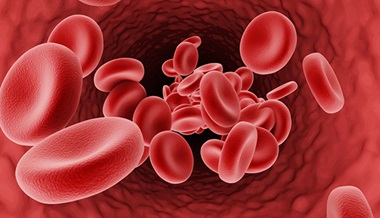Vitamin B12 Deficiency Anemia
What is vitamin B12 deficiency anemia?
Vitamin B12 deficiency anemia is a condition in which your body does not have enough healthy red blood cells, due to a lack (deficiency) of vitamin B12. This vitamin is needed to make red blood cells, which carry oxygen to all parts of your body. Without enough red blood cells, your tissues and organs don’t get enough oxygen. Without enough oxygen, your body can’t work as well.
Folic acid, also called folate, is another B vitamin. Anemias caused by a lack of vitamin B12 or a lack of folate are 2 types of megaloblastic anemia. With these types of anemia, the red blood cells don’t develop normally. They are very large. And they are shaped like an oval, not round like healthy red blood cells. This causes the bone marrow to make fewer red blood cells. In some cases the red blood cells die sooner than normal.
What causes vitamin B12 deficiency anemia?
Vitamin B12 deficiency anemia is more common in people whose families come from northern Europe. It is caused by one of the following:
- Lack of intrinsic factor. Intrinsic factor is a protein made in the stomach. It is needed to absorb vitamin B12. This type of B12 deficiency anemia is called pernicious anemia.
- Surgery that removes or bypasses the end of the small intestine. This part of the small intestine is where vitamin B12 is absorbed.
The inability to make intrinsic factor may be caused by several things, such as:
- Chronic gastritis
- Surgery to remove all or part of the stomach (gastrectomy)
- An autoimmune condition, where the body attacks its own tissues
Other types of megaloblastic anemia may be linked with type 1 diabetes, thyroid disease, and a family history of the disease.
The inability to make intrinsic factor may be the result of several factors, such as chronic gastritis, gastrectomy (removal of all or part of the stomach), or an autoimmune condition (the body attacks its own tissues). Other types of megaloblastic anemia may be associated with type 1 diabetes, thyroid disease, and a family history of the disease.
Who is at risk for vitamin B12 deficiency anemia?
Risk factors for vitamin B12 deficiency anemia include:
- A family history of the disease
- Having part or all of your stomach or intestine removed
- Autoimmune diseases, including type 1 diabetes
- Crohn's disease
- HIV
- Some medicines
- Strict vegetarian diets
- Being an older adult
What are the symptoms of vitamin B12 deficiency anemia?
Each person’s symptoms may vary. Symptoms may include:
- Weak muscles
- Numb or tingling feeling in hands and feet
- Trouble walking
- Nausea
- Decreased appetite
- Weight loss
- Irritability
- Lack of energy or tiring easily (fatigue)
- Diarrhea
- Smooth and tender tongue
- Fast heart rate
The symptoms of megaloblastic anemia may look like other blood conditions or health problems. Always see your healthcare provider for a diagnosis.
How is vitamin B12 deficiency anemia diagnosed?
This type of anemia is usually found during a medical exam through a routine blood test. Your healthcare provider will take your medical history and give you a physical exam.
Your provider may give you additional blood tests. You may also have other evaluation procedures, such as a bone marrow biopsy.
How is vitamin B12 deficiency anemia treated?
Your healthcare provider will figure out the best treatment for you based on:
- How old you are
- Your overall health and medical history
- How sick you are
- How well you handle certain medicines, treatments, or therapies
- If your condition is expected to get worse
- Your opinion or preference
Vitamin B12 deficiency anemia and folate deficiency anemia often occur together and can be hard to tell apart. Treatment may include vitamin B12 shots (injections) and folic acid pills.
Foods that are rich in folic acid include the following:
- Orange juice
- Oranges
- Romaine lettuce
- Spinach
- Liver
- Rice
- Barley
- Sprouts
- Wheat germ
- Soy beans
- Green, leafy vegetables
- Beans
- Peanuts
- Broccoli
- Asparagus
- Peas
- Lentils
- Chickpeas (garbanzo beans)
Foods that are rich in both folic acid and vitamin B12 include the following:
- Eggs
- Meat
- Poultry
- Milk
- Shellfish
- Fortified cereals
Taking folic acid by mouth is more effective than eating foods rich in folic acid. Vitamin B12 is not as well absorbed by mouth as per injection.
Living with vitamin B12 deficiency anemia
Depending on the cause of your vitamin B12 deficiency, you may need to take vitamin B12 supplements for the rest of your life. These may be pills or shots. This may seem difficult. But it will let you live a normal life without symptoms.
If your deficiency is due to a restrictive diet, you may want to work with a nutritionist. He or she can help ensure that you get enough vitamin B12 and other vitamins. Tell your healthcare provider about any symptoms and follow your treatment plan.
Key points about vitamin B12 deficiency anemia
- With this condition, your body does not have enough healthy red blood cells, due to a lack (deficiency) of vitamin B
- It is one of several types of megaloblastic anemia.
- Without enough red blood cells, your tissues and organs don’t get enough oxygen. Without enough oxygen, your body can’t work as well.
- Symptoms include weak muscles, numbness, trouble walking, nausea, weight loss, irritability, fatigue, and increased heart rate.
- Treatment may include vitamin B12 supplements. It is also important to eat a well-balanced diet.
Next steps
Tips to help you get the most from a visit to your healthcare provider:
- Know the reason for your visit and what you want to happen.
- Before your visit, write down questions you want answered.
- Bring someone with you to help you ask questions and remember what your provider tells you.
- At the visit, write down the name of a new diagnosis, and any new medicines, treatments, or tests. Also write down any new instructions your provider gives you.
- Know why a new medicine or treatment is prescribed, and how it will help you. Also know what the side effects are.
- Ask if your condition can be treated in other ways.
- Know why a test or procedure is recommended and what the results could mean.
- Know what to expect if you do not take the medicine or have the test or procedure.
- If you have a follow-up appointment, write down the date, time, and purpose for that visit.
- Know how you can contact your provider if you have questions.




